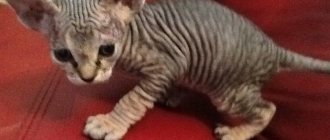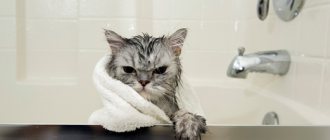The reasons why pododermatitis develops in cats are varied, so in order to cure this disease, you must first find and eliminate the original source of the problem. If your cat has sores on the paw pads that bleed and do not go away for a long time, you should not hesitate to visit the veterinarian, as untimely treatment leads to serious consequences.
Causes and risk factors
Until now, the exact root causes of this disease of cat paws have not been clarified. It is assumed that the trigger for the development of pathology may be a decrease in immunity and activation of opportunistic microflora. This includes various types of bacteria and fungi. While the immune system copes with the load, microorganisms are in a latent state, but at the slightest failure they are activated, causing various diseases, including pododermatitis.
Another suspected reason is negative environmental factors. Diseases of the paws and fingers often appear on cold days when there is severe frost outside. In such conditions, the paw pads freeze, peel, and then crack. Often contact with chemicals used to combat snow and ice causes wounds on unprotected pads. The sore can also occur due to the introduction of a strong allergen into the cat’s body. A.N. Gehrke, Ph.D., veterinary dermatologist, suggests that feline plasmacytic pododermatitis may begin to progress against the background of autoimmune disorders (vetpharma.org/articles/66/4787/). However, such a pathology is difficult to diagnose, so often the original source of the disease becomes unclear.
The risk group for developing this pathological process includes all breeds of cats, regardless of age and environmental conditions.
Inflammation of the corolla
Inflammation of the corolla can begin as a result of a strong blow, or as a consequence of an infectious process on different parts of the front and hind legs. If you start this process, the body will begin to reject the claw, and it will need to be removed in a hospital. During the inflammatory process, disinfection is mandatory.
In particularly advanced cases, when gentle methods are ineffective, the claws must be extirpated. After this, the animal will develop lameness, but the cat will remain active and will be able to live a normal life.
Manifestation of the disease
As the disease progresses, sores may appear on the pads of the feet.
Normally, a healthy cat has pads on the front and hind paws (including the carpal paws), pink, smooth, and moderately dry. With pododermatitis, in the initial stages of development, the cat's paw pads increase slightly in size, but discomfort is not yet a concern, which is why it is so difficult to diagnose the pathology at stage 1. Further, the affected areas soften, their color becomes unnaturally bluish. It is difficult to notice the pathology if the seals' pads are black, but if you look closely, you will be able to notice peeling and hair falling out in the affected areas. In advanced stages, bacterial inflammation occurs; in places where the pads are cracked, red bleeding wounds appear that do not heal. The paws are hot to the touch and very dry. If the pathology is not treated, necrosis develops, which often leads to the death of the pet.
Therapy
Treatment methods and techniques are selected based on the characteristics and type of pathogen, or negative environmental factor, under the influence of which inflammation occurred in each specific case. Thus, antibiotics are used for bacterial infections, acaricidal drugs are prescribed if pododermatitis occurs due to the action of parasitic mites. A therapeutic dose of prednisolone will help combat some of the inflammation caused by the autoimmune disease. In all cases, it is useful to wash the animal’s paws using antiseptic agents.
Diagnostic methods
If your cat's pads are cracking, and the wound is bleeding and does not heal for a long time, you should not delay a visit to the veterinarian. After the initial examination, a sample is taken from the affected area for microscopic, cytological and histological examination. The sensitivity of the identified pathogen to antibiotics is also determined.
It is important that the doctor distinguishes the animal’s disease from pemphigus foliaceus in time.
There are other dangerous diseases in which the paw pads peel off and become an unnatural color. Therefore, differential diagnosis must be carried out, which will help exclude such pathologies:
- eosinophilic granuloma;
- neoplasia;
- pemphigus foliaceus;
- injury.
Pads to survive
Our beloved cats tiptoe through life. And the point is not in the beauty and grace of such a gait - people with mustaches hardly think about this. Simply walking and running on your toes increases the chances of a successful hunt - thus the swing becomes longer and the speed is higher.
In addition, the pads work as sound absorbers - it’s not without reason that they say: she walked in quietly, like a cat. The pads soften both the sound of a jump and the sound of a step, which is especially important when hunting. A cat that sneaks around on tiptoe is very difficult for potential prey to notice!
The small paw pads contain a large number of nerve endings that help assess temperature and surface texture, as well as sense unevenness, which helps maintain balance.
Also, these nerve endings very sensitively pick up the slightest vibration - this is what is associated with the ability of cats, and many other animals, to “predict” earthquakes. There is nothing mystical here; cats begin to show anxiety several hours before the first tremors, as they sense the slight vibration of the soil that precedes it.
How to treat?
Drug treatment
If the pads on a cat’s paws are dry, severely cracked, and due to bleeding sores the animal cannot move normally, complex drug treatment is prescribed. The following groups of drugs are used:
- Systemic glucocorticosteroids. Reduce the manifestation of the disease, eliminate inflammation. The dosage is determined by the doctor taking into account the weight and age of the cat. The following drugs are used: Prednisolone;
- "Methylprednisolone."
- "Doxycycline";
To increase immunity, immunostimulating agents, vitamins, mineral complexes, and dietary supplements are prescribed.
Surgical
Sometimes the animal's recovery depends on the operation.
Sometimes drug treatment does not bring results. The pads remain modified and deformed. As a result, the animal cannot move normally, as the enlarged tissues interfere. In this case, the doctor will advise removing the affected area. After surgery, pododermatitis completely disappears without the use of medications.
Ingrown claws in cats
Cats need to scratch non-stop to keep their claws sharp and clean. When members of the cat family are unable to sharpen their claws, health problems occur. For pets, you need to install a scratching post at home so that cats can have the opportunity to stretch their claws without any problems.
Ingrowth occurs more often in cats that are not very active. Therefore, the owner needs to monitor the condition of the animal’s claws and maintain them in a normal form - trim off the excess so that the paw pads do not grow into the soft tissues. Because of this, the paw will hurt, and inflammation and even a purulent process may begin in the claw area due to the accumulation of dirt in this place. In this case, the veterinarian should prescribe medication for the cat.
If the problem is not treated, the inflammatory process will cause discomfort and pain to the animal, prevent the cat from moving normally, and the animal will limp. It is recommended to trim ingrown claws at home with special pliers, or use the services of a specialist.
Prevention
To prevent the development of pododermatitis, it is important to constantly examine the animal’s paws, even if the cat is black, the disease will be visible by peeling and unnatural dryness. As a preventive measure, it is recommended to wash the cat’s paws with disinfectants, not let him go outside during the cold season, and increase the body’s protective functions. If there are characteristic symptoms, do not self-medicate, but urgently take your pet to the hospital. If diagnosis and treatment are timely, complications can be avoided.
Foreign bodies in a cat's pads
When the cat starts:
- lick your paw all the time
- hide it under your body
- limp
This is an accurate symptom of a foreign object getting into the soft tissue of an animal’s paw. Because of this, there is a high probability of skin damage and serious infections, which will cause great inconvenience and pain to the cat.
If you do not remove the foreign body from the paw and do not start treatment, the inflammation will intensify, and the virus will go into the tissues of the joints, tendons, and subcutaneous tissue and cause terrible consequences, such as amputation of a pet’s limb. At the first signs of illness, it is necessary to carefully examine the cat’s paws, and in severe cases, seek help from a specialist.
Cat paw print
The print of a cat's paw is round, without traces of claws, because representatives of the family walk with retracted claws that do not touch the ground. The paws leave a mark of four toes and, no matter the hind leg or the front leg, and the metacarpal soft. The two front fingers are located in close proximity to each other, while the side ones are slightly distant from the central ones. When landing a jump, a profitable fingerprint may be left behind. When pursuing prey, the tracks of the four legs come closer together.
Why does a pet move its paws and purr on the bed or sofa?
These animals do not always choose their owners as objects for pawing. You can often notice that a cat climbs onto a bed or sofa and crumples a blanket or bedspread with its paws. Why is she doing this? There may be several reasons why cats stomp on the bed. This is probably how pets prepare a place to rest, relieve emotional stress, realize sexual instinct, or leave marks.
Preparing a place to rest
Instincts can explain why many cats stomp on the bed before dozing off. The wild ancestors of these animals trampled down grass and leaves before settling down to rest. So they prepared their bedding and checked whether the rookery was comfortable for sleeping. Pets, who do not need to prepare their own place to rest, do it instinctively. Before falling asleep, many of them trample down the blanket or bedspread.
Stress relief
Some owners of these pets notice that sometimes they sit on the bed or sofa and, frowning, begin to vigorously knead the blanket or bedspread, without making any sounds. This behavior means that the animal is offended or upset by something, and by moving its paws it is trying to get rid of negative emotions.
Cats behave this way, as a rule, after they have been denied a treat, scolded for wrongdoing, unceremoniously woken up, driven away from a heated place, etc. Rhythmic monotonous movements of their paws help them quickly calm down and relieve stress, because, as already noted Previously, they still associate pawing with a feeling of security and peace.
Unrealized sexual instinct
Why do some pets climb onto the bed, stomp on it, arching their backs and meowing loudly? This behavior is probably associated with the beginning of the mating season. You can recognize it by the fact that the cat tramples the sofa or bed not with its front paws, as usual, but with its hind paws, and the cat grabs the bedspread with its teeth. This usually does not last long; after 10–14 days or with the onset of pregnancy, the fingering of the paws and expressive meowing stops. The male can be caught doing this activity at any time.
Animal marks territory
When cats trample on the couch, they may be trying to secure sole ownership of the bed. Why did the cat need furniture? On the pads of their paws there are sweat glands that secrete special odorous substances, with the help of which these animals mark the territory so that rivals do not lay claim to it. Probably, appreciating the comfort and softness of the bed for rest and wanting to sleep on it all the time, animals try to make their desire obvious to others by moving their paws.
Help from a veterinarian
The veterinary clinic will help in the most severe cases: when the wound becomes infected and the claw grows deep into the paw. The doctor will conduct an examination. Assess the complexity of the case, the degree of claw ingrowth and the need for surgical intervention.
If the claw is not deeply ingrown and there is no inflammation, the veterinarian will remove the claw using special tools. The wound will be treated with an antiseptic to avoid inflammation. If the wound festers, a decision is made to operate. It is performed under local anesthesia. The place of suppuration is opened, the pus and the ingrown claw are removed. The wound is disinfected.
In severe cases, the operation is performed under general anesthesia. A small incision is made at the site where the claw grows in. The claw is cut off and carefully removed. The accumulated pus is cleaned out. The wound is treated with an antiseptic solution. At the end, a sterile bandage is applied.
Thermoregulation pads
You won't find a cat with sweaty armpits anywhere! And not because cats don’t sweat—every living creature needs a thermoregulation mechanism. They just sweat through their paw pads. Those who have visited the veterinarian with their pet have probably noticed small paw prints on the examination table.
This means that the tailed friend has experienced not the most pleasant moments in his life. However, cats do not only sweat during times of stress. On hot days, this “cooling system” helps avoid overheating.
Pododermatitis
Pododermatitis or inflammation of the soft tissues of the paws is the most common disease in cats and dogs. During pododermatitis, the animal has difficulty taking normal steps, and any movement leads to severe discomfort and pain. Because of this, cats and kittens develop nervousness and aggressive behavior.
© shutterstock
It is difficult to identify this diagnosis in the first stages; they are impossible for the average person to notice. Therefore, the disease starts, and the consequences become irreversible.
Causes of the disease:
- influence of pathogenic bacteria. When a cat has injured its paw, the variation in bacteria entering the body increases significantly. Incorrect disinfecting manipulations cause fungal manifestations in the tissues of the paws. It is difficult to detect and even more difficult to treat. Most often, the result is a chronic fungal disease.
- hypothermia. During the cold period, there is a risk of severe hypothermia, and therefore it is not recommended to let cats go for a walk during this period. The streets are filled with chemicals, and they can irritate the delicate tissue of the paws, which can cause necrosis in felines. Because of this, the pads are completely destroyed, and as a result - lameness.
- exposure to allergens. Allergens can cause dermatitis; indoor cats are more susceptible to this. A weakened animal's immune system may not cope well with this disease.
- consequences of autoimmune diseases. Most often, plasmacytic pododermatitis appears after autoimmune diseases. Due to the late detection and treatment of the disease, it is necessary to give the cat special medications throughout its life to keep the disease under control.
Symptoms and diagnosis of pododermatitis
Every second observation will help to identify any disease in the early stages, and contacting a specialist in the early stages will help to avoid negative consequences and quickly cure feline diseases in a cat.
In the initial stages of paw pad problems, there are various symptoms:
- the cat spends a lot of time on paw hygiene
- the pads are very soft
- From time to time blood is visible on the surface of the pads
Ignoring any of the signs can contribute to the development of severe necrosis, which carries with it a high likelihood of sepsis. In this case, veterinarians cannot guarantee a high survival rate for the cat, and most methods of treating the disease are ineffective.
© shutterstock











